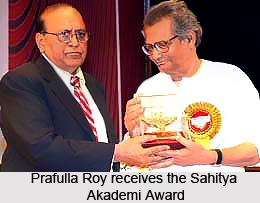 Sahitya Akademi Award is given away every year by the Sahitya Akademi, India`s National Academy of Letters, to one writer every year in each of the languages recognised by it, as well as for translations. This is the second highest literary award of India, after Jnanpith Award. The awards given to Bengali writers for works in Bengali and English as well as for translations from Bengali literature are given below:
Sahitya Akademi Award is given away every year by the Sahitya Akademi, India`s National Academy of Letters, to one writer every year in each of the languages recognised by it, as well as for translations. This is the second highest literary award of India, after Jnanpith Award. The awards given to Bengali writers for works in Bengali and English as well as for translations from Bengali literature are given below:
| Year | Author | Year | Author |
| 1955 | Jibanananda Das - Shreshtha Kabita (poetry) | 1982 | Kamal Das - Amritasya Putri (novel) |
| 1956 | Tarashankar Bandyopadhyay - Arogya Niketan (novel) | 1983 | Shakti Chattopadhyay - Jete Pari Kintu Keno Jabo (poetry) |
| 1957 | Premendra Mitra - Sagar Theke Phera (poetry) | 1984 | Samaresh Majumdar - Kalbela (novel) |
| 1958 | Parashuram - Anandibai Ityadi Galpo (short stories) | 1985 | Sunil Gangopadhyay - Sei Samay (novel) |
| 1959 | Gajendra Kumar Mitra - Kolkatar Kachhei (novel) | 1986 | Amiya Bhushan Majumdar - Raj Nagar (novel) |
| 1960 | Not given | 1987 | Arun Mitra - Khunjte Khunjte Eto Dur (poetry) |
| 1961 | Shashi Bhushan Dasgupta - Bharater Shakti-Sadhana O Shakta Sahitya (non-fiction) | 1988 | Ramapada Chaudhuri - Bari Badle Jay (novel) |
| 1962 | Annada Shankar Ray - Japane (travelogue) | 1989 | Shirshendu Mukhopadhyay - Manab Jamin (novel) |
| 1963 | Amiya Chakrabarti - Ghare Pherar Din (poetry) | 1990 | Debesh Ray - Tista Parer Brittanta (novel) |
| 1964 | Subhash Mukhopadhyay - Jato Durei Jai (poetry) | 1991 | Moti Nandi - Sada Kham (novel) |
| 1965 | Bishnu Dey - Smriti Satta Bhabishyat (poetry) | 1992 | Alok Ranjan Dasgupta - Marami Karat (poetry) |
| 1966 | Manoj Basu - Nishi-Kutumba (novel) | 1993 | Shyamal Gangopadhyay - Shahjada Darashukoh (novel) |
| 1967 | Buddhadeb Basu - Tapaswi O Tarangini (verse play) | 1994 | Syed Mustafa Siraj - Alik Manush (novel) |
| 1968 | Not given | 1995 | Naresh Guha - Kabita Sangraha (poetry) |
| 1969 | Manindra Ray - Mohini Aral (poetry) | 1996 | Ashok Mitra - Tal Betal (non-fiction) |
| 1970 | Abu Sayeed Ayyub - Adhunikata O Rabindranath (non-fiction) | 1997 | Nabarun Bhattacharya - Herbert (novel) |
| 1971 | Uma Prasad Mukhopadhyay - Mani-Mahesh (travelogue) | 1998 | Dibyendu Palit - Anubhab (novel) |
| 1972 | Santosh Kumar Ghosh - Shesh Namaskar (novel) | 1999 | Nabanita Deb-Sen - Naba-Nita (prose poetry) |
| 1973 | Not given | 2000 | Jay Goswami - Pagli Tomar Sange (poetry) |
| 1974 | Nirendranath Chakrabarti - Ulanga Raja (poetry) | 2001 | Atin Bandyopadhyay - Panchashati Galpo (short stories) |
| 1975 | Bimal Kar - Asamay (novel) | 2002 | Sandipan Chattopadhyay - Ami O Banbihari (novel) |
| 1976 | Maitreyi Devi - Na Hanyate (novel) | 2003 | Prafulla Ray - Krantikal (novel) |
| 1977 | Shankha Ghosh - Babarer Prarthana (poetry) | 2004 | Sudhir Chakrabarti - Baul Fakir Katha (non-fiction) |
| 1978 | Shankari Prasad Basu - Vivekananda O Samakalin Bharatvarsha (non-fiction) | 2005 | Binay Majumdar - Haspatale Lekha Kabitaguchchha (poetry |
| 1979 | Mahashweta Devi - Aranyer Adhikar (novel) | 2006 | Dhrubaputra - Amar Mitra (Novel) |
| 1980 | Samaresh Basu - Shamba (novel) | 2007 | Amar Samay Alpa - Samarendra Sengupta (Poetry) |
| 1981 | Radha Raman Mitra - Kalikata Darpan (non-fiction) |




















